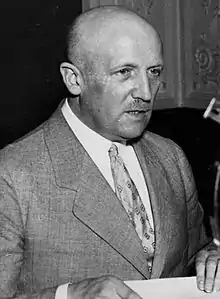Von Schleicher Cabinet
The Von Schleicher Cabinet de jure formed the government of Weimar Germany between 3 December 1932 and 28 January 1933 upon the resignation of Franz von Papen. The cabinet was made up of holdovers from Papen's which featured many right-wing independents or German National People's Party (DNVP). The government was followed by the Hitler Cabinet after Schleicher's own resignation. This was to be the last Weimar government before the rise of Nazi Germany.
| Von Schleicher Cabinet | |
|---|---|
Cabinet of Weimar Germany | |
| 3 December 1932 – 28 January 1933 | |
 | |
| Date formed | 3 December 1932 |
| Date dissolved | 28 January 1933 |
| People and organisations | |
| Head of state | Paul von Hindenburg |
| Head of government | Kurt von Schleicher |
| Deputy head of government | vacant |
| History | |
| Legislature term(s) | 7th legislature of the Diet of the Realm |
| Predecessor | Von Papen Cabinet |
| Successor | Hitler Cabinet |
Composition
The Reich cabinet consisted of the following Ministers:
| Portfolio | Minister | Took office | Left office | Party | |
|---|---|---|---|---|---|
| Chancellor of the German Reich | Kurt von Schleicher | 3 December 1932 | 28 January 1933 | Independent | |
| Vice-Chancellor of the German Reich | vacant | 3 December 1932 | 28 January 1933 | Independent | |
| Reich Minister of Foreign Affairs | Konstantin von Neurath | 3 December 1932 | 28 January 1933 | Independent | |
| Reich Minister of the Interior | Franz Bracht | 3 December 1932 | 28 January 1933 | Centre | |
| Reich Minister of Finance | Lutz Graf Schwerin von Krosigk | 3 December 1932 | 28 January 1933 | Independent | |
| Reich Minister of Justice | Franz Gürtner | 3 December 1932 | 28 January 1933 | DNVP | |
| Reich Minister of the Reichswehr | Kurt von Schleicher | 3 December 1932 | 28 January 1933 | Independent | |
| Reich Minister of Economics | Hermann Warmbold | 3 December 1932 | 28 January 1933 | Independent | |
| Reich Minister for Food and Agriculture | Magnus von Braun | 3 December 1932 | 28 January 1933 | DNVP | |
| Reich Minister for Labour | Friedrich Syrup | 3 December 1932 | 28 January 1933 | Independent | |
| Reich Minister for Postal Affairs | Paul Freiherr von Eltz-Rübenach | 3 December 1932 | 28 January 1933 | Independent | |
| Reich Minister for Transport | Paul Freiherr von Eltz-Rübenach | 3 December 1932 | 28 January 1933 | Independent | |
| Reich Minister for Employment | Günther Gereke | 3 December 1932 | 28 January 1933 | Independent | |
| Ministers without portfolio | Johannes Popitz | 3 December 1932 | 28 January 1933 | Independent | |
Actions
During von Schleicher's short time as Chancellor he attempted to prevent the rise of the NSDAP by offering Hitler the Chancellorship in exchange for him remaining as minister of defense however this was rejected. Schleicher eventually agreed to a deal in which Hitler would become Chancellor, von Papen would become Vice-Chancellor and the cabinet would be composed of non-NSDAP members.[1] Schleicher also attempted to split the NSDAP by convincing Gregor Strasser to leave by offering him the Vice-Chancellorship and control of Prussia. After negotiations with Strasser failed he went to Hindenburg with a proposal to declare a state of emergency to control the NSDAP and dissolve the Reichstag, but Hindenburg refused.[2] His final action as Chancellor was to ask Hindenburg once more to declare a state of emergency and when this was refused once more he resigned.
State of Emergency
Schleicher's main goal during his Chancellorship was to have a state of emergency declared by Hindenburg in order to prevent Hitler from gaining power, prevent another election, and to restore stability to the Weimar government. However, he would not declare a state of emergency with his authority and Hindenburg was concerned that he could be impeached for doing so. By January multiple party leaders were demanding another election, with the leader of the Centre party stating that it would be unconstitutional to stall the elections if there was no need for a state of emergency. Following Schleicher's resignation the election was held in March with the NSDAP gaining 92 seats.[3]
References
- "Why the Nazis achieved power". Archived from the original on 2018-11-24. Retrieved 2018-11-23.
- "The Republic Collapses". Archived from the original on 2018-12-29. Retrieved 2018-11-23.
- "KURT VON SCHLEICHER—THE SOLDIER AND POLITICS IN THE RUN-UP TO NATIONAL SOCIALISM: A CASE STUDY OF CIVIL-MILITARY RELATIONS" (PDF).
